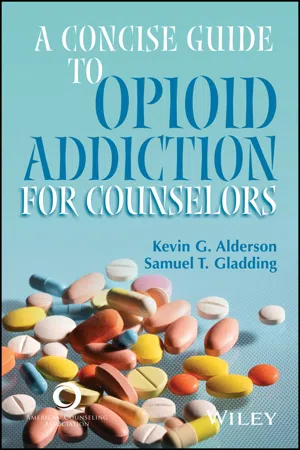
- English
- ePUB (mobile friendly)
- Available on iOS & Android
A Concise Guide to Opioid Addiction for Counselors
About this book
This brief, evidence-based guide is ideal for busy mental health professionals helping clients with opioid use disorders (OUDs). It examines the devastating global impact caused by opioids and is replete with information and resources that can be immediately applied to addiction work. The authors' pragmatic, strengths-based approach to treatment is based on a collaborative counselor-client working alliance to achieve client readiness for change, moderation, and abstinence. Topics discussed include current research on risk and protective factors, OUD assessment and diagnosis, the ethical and legal issues particular to addiction work, medication-assisted treatment, physical and psychological interventions for pain management, and the necessity of interdisciplinary care.
In addition, Drs. Alderson and Gladding provide a number of counseling approaches and treatment options that consider work with women, youth, people of color, LGBTQ+ individuals, veterans, older adults, people with disabilities, individuals in the criminal justice system, and rural residents. Five useful appendices conclude the book, including a listing of 20 opioid drugs in descending order of potency; common ICD-10, ICD-10-CM, and ICD-11 codes; and a glossary of terms and abbreviations.
*Requests for digital versions from ACA can be found on www.wiley.com
*To request print copies, please visit the ACA https://imis.counseling.org/store/detail
*Reproduction requests for material from books published by ACA should be directed to [email protected]
Frequently asked questions
- Essential is ideal for learners and professionals who enjoy exploring a wide range of subjects. Access the Essential Library with 800,000+ trusted titles and best-sellers across business, personal growth, and the humanities. Includes unlimited reading time and Standard Read Aloud voice.
- Complete: Perfect for advanced learners and researchers needing full, unrestricted access. Unlock 1.4M+ books across hundreds of subjects, including academic and specialized titles. The Complete Plan also includes advanced features like Premium Read Aloud and Research Assistant.
Please note we cannot support devices running on iOS 13 and Android 7 or earlier. Learn more about using the app.
Information

CHAPTER 1
Introduction to Opioids and the Counseling Approach
A Note on Terminology
The Beginnings of a Crisis
An Introduction to Opioids
- Naturally occurring narcotics, which are also called opiates (i.e., codeine, morphine, oripavine, and thebaine).
- Semisynthetic narcotics, which are produced in labs using natural opiates (e.g., heroin is made from morphine, whereas oxycodone can be made from thebaine or codeine, which itself can be made from morphine).
- Synthetic narcotics, which are also produced in labs and have a chemical structure similar to opiates (e.g., fentanyl, methadone).
Box 1.1 • Frank’s Story: Getting High on Heroin and Other Opioids1
Table of contents
- Cover
- Table of Contents
- Title Page
- Copyright Page
- Dedication
- Preface
- Acknowledgments
- About the Authors
- CHAPTER 1: Introduction to Opioids and the Counseling Approach
- CHAPTER 2: Diagnosis and Assessment of Opioid Use Disorders
- CHAPTER 3: Ethical and Legal Issues in Addiction Counseling
- CHAPTER 4: Addiction Essentials
- CHAPTER 5: Comparing Medicinal, Problematic, and Addictive Use of Opioids
- CHAPTER 6: Evidence-Based Medications and Physical Interventions
- CHAPTER 7: Counseling Opioid-Addicted Individuals
- CHAPTER 8: Diversity Considerations
- Conclusion
- References
- APPENDIX A: Twenty Opioid Drugs in Descending Order of Potency
- APPENDIX B: Common ICD-10, ICD-10-CM, and ICD-11 Codes
- APPENDIX C: Signs That Someone Is Abusing Opioids
- APPENDIX D: Glossary of Terms and Abbreviations
- APPENDIX E: Resources
- Index
- Technical Support
- End User License Agreement